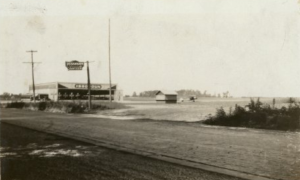Hudson's Aviation History: Mid-City Airport
by James F. Caccamo
Ex Libris, January 1980 Vol II, No. 1
It was hailed as the airport of the future. Its founders saw it as the perfectly located field—after all, how could it miss? It was centered between Akron and Cleveland. The time was the mid-1920’s, and the site was near the present-day Terex plant in southern Hudson Township. Little did the founders of Issoudon Mid-City Airport realize that the very reasons that made the site favorable for an airport (relatively flat terrain, close to state routes, and a central location) would also make it desirable to General Motors in 1956, thus cause the field’s demise early in 1957.
In the mid-1920’s, though, there were few airports to serve the growing enthusiasm for aviation. Major Thomas G. Lanphier and Colonel Henry Breckenridge decided to implement their plans for an airport in the Akron-Cleveland region. They named the field “Issoudon” as a memorial to the pilots who trained under Lanphier in France. “Mid-City” was added to show the port’s geographic centricity with Akron and Cleveland. Eventually, the “Issoudon” would be dropped.

In 1927, the field was so successful that a hanger was built [see photo]/ Of his creation, Lanphier said “The field is located in the heart of the Detroit-Cleveland-Pittsburgh industrial district.” Obviously, Lanphier’s aspirations were expanding. He also pointed out that the port was relatively close to Lake Erie, but far enough away to avoid much of the ground fog.
Plans were made to make 3000-foot runaways, and to eventually extend the runways to 11,000 feet. The founders had also planned to connect their airport with the spur of the commuter rail line that ran between Akron and Cleveland. The port hangar that was built in 1927 was a double-storage type, and even at the time of its demolition in the mid-Fifties, was considered to be one of the finest hangar facilities in the area.
Unfortunately, the Depression interfered with the founders’ dreams. Mid-City was never to become the big-city transportation hub that they had envisioned. The port was still of great use, especially for flying clubs and student pilots. Local lore has it that Lindbergh even landed there. Some claimed that Lindbergh used an alias so that he could land incognito. The evidence is not, however, conclusive.
When General Motors became interested in locating its Euclid Division (now Terex) in the area, Mid-City Field was still a thriving enterprise. Unfortunately for the pilots and the clubs that used the airport regularly, the owner at the time, E.H. Doge of Akron, decided to accept a GM offer for the land. The operators of the field, James B. Ottney and Margaret B. Williams, were told unceremoniously to move. The pilots and clubs that used the facilities were advised to find a new home field. Attempts were made by Ottney and Williams to block eviction through court action; GM, however, prevailed.
Although the destruction of the port was briefly delayed by lawsuits, Mid-City is no more. Hudson’s role in aviation history had ended. The airport that saw many experimental planes and countless pilots was gone. Mid-City, a dream that grew out of the promise of the 1920’s, would be forever an unfilled promise.



